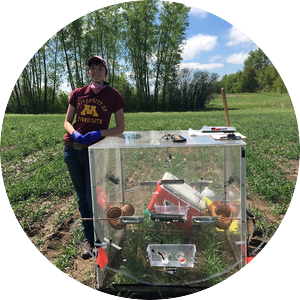Stella Woeltjen's doctoral thesis defense seminar
LAAS PhD candidate advised by Profs. Jess Gutknecht and Jake Jungers
Intermediate wheatgrass (IWG, Thinopyrum intermedium (Host) Barkworth and Dewey), a cool-season grass domesticated for grain and forage production, is currently gaining attention as a perennial alternative to annual grain crops. The extensive root systems, high carbon (C) uptake and belowground C partitioning, and well-developed nitrogen (N) conservation strategies make perennial crops like IWG well-suited to improve soil C storage and minimize N inputs and losses. However, little is known about how these attributes are expressed in IWG systems, and whether these processes change within a growing season and across IWG stand age. As IWG stands often remain in production for 3 - 5 years, this gap in knowledge significantly challenges the understanding of how IWG can be profitably managed and how it will contribute to soil C storage and crop-soil N retention as stands age. To evaluate these ideas, we established three studies to address stand age-related effects on IWG 1) root growth and decomposition, 2) C uptake and partitioning to crop-soil-microbial pools, and 3) N sources and N conservation.
Together, these studies illuminated important changes in resource use and nutrient availability that develop over the 1 – 3 years following IWG establishment. Within just two years of establishment, we saw clear evidence that IWG shifts from a system dominated by root growth and belowground C allocation, to one characterized by root decomposition and exportation of new C inputs via soil respiration. While the enhanced decomposition in the second-year IWG suggests a greater capacity to transform root-derived C into more stable soil C compounds and recycle root-derived N into soil pools, the increase in decomposition may also signal changes in the nutrient status of IWG that could be detrimental to the ability of it to contribute to soil C accrual. We found an increased reliance on N derived from fertilizer and N derived from internal translocation in older stands, and coupled with the evidence of limited N availability in crop tissues and soil pools in older IWG stands, we conclude that N limitation of IWG in ageing stands should be a concern for producers. As such, optimizing IWG N management recommendations to more adequately meet the N demands of IWG will be critical to maximizing IWG contributions to soil C storage, reducing reliance on external fertilizer inputs and ensuring IWG remains a profitable and sustainable alternative to annual grains in agricultural landscapes.

Stella Woeltjen, LAAS PhD candidate advised by Profs. Jess Gutknecht and Jake Jungers
